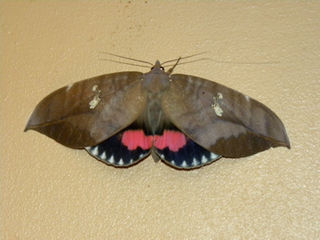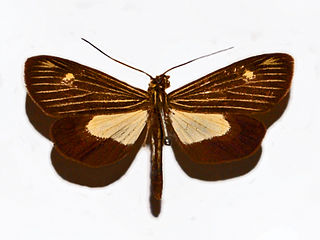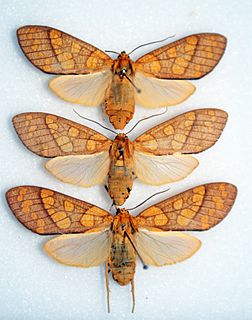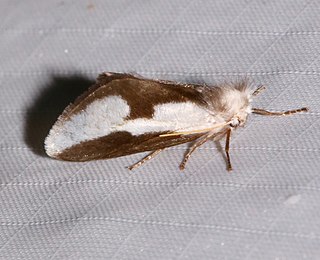Related Research Articles

Metaxanthia is a genus of moths in the family Erebidae. The genus was erected by Herbert Druce in 1899.
Nodozana is a genus of moths in the subfamily Arctiinae erected by Herbert Druce in 1899.
Procymbopteryx is a monotypic moth genus of the family Crambidae erected by Eugene G. Munroe in 1961. Its only species, Procymbopteryx belialis, was first described by Herbert Druce in 1899. It is found in the Mexican state of Guerrero and the US state of Arizona.
Syngamia is a genus of moths of the family Crambidae.
Somatoxena is a monotypic moth genus in the subfamily Lymantriinae erected by Per Olof Christopher Aurivillius in 1904. Its only species, Somatoxena lasea, was first described by Herbert Druce in 1899. It is found in Sierra Leone.

Phyllodes imperialis, the imperial fruit-sucking moth or pink underwing moth, is a noctuoid moth in the family Erebidae, subfamily Calpinae. It was first described by Herbert Druce in 1888. The species can be found in north-eastern Queensland to northern New South Wales, Papua New Guinea, Solomons, Vanuatu and New Caledonia.
Camaegeria sophax is a moth of the family Sesiidae first described by Herbert Druce in 1899. It is known from Malawi, Mozambique, Uganda and Zimbabwe.

Erbessa cingulina is a moth of the family Notodontidae first described by Herbert Druce in 1885.

Elysius sebrus is a moth of the family Erebidae. It was described by Herbert Druce in 1899. It is found in Brazil and Bolivia.
Hypocrita crocota is a moth of the family Erebidae. It was described by Herbert Druce in 1899. It is found in Ecuador.

Hypocrita eulalia is a moth of the family Erebidae. It was described by Herbert Druce in 1899. It is found in Brazil and Peru.
Metaxanthia vespiformis is a moth of the family Erebidae first described by Herbert Druce in 1899. It is found in Brazil, Peru, Colombia, Ecuador, French Guiana, Guyana and Costa Rica.
Pryteria unifascia is a moth in the family Erebidae. It was described by Herbert Druce in 1899. It is found in Guyana and Belize.
Scoliacma brunnea is a moth in the family Erebidae. It was described by Herbert Druce in 1899. It is found in New Guinea. The habitat consists of both lowlands and areas at higher altitudes.
Talara leucocera is a moth in the subfamily Arctiinae. It was described by Herbert Druce in 1899. It is found in Espírito Santo, Brazil.
Abegesta remellalis, the white-trimmed abegesta or white-trimmed brown pyralid moth , is a moth in the family Crambidae. It was described by Herbert Druce in 1899. It is found in Mexico and the south-western United States, where it has been recorded from Arizona, California and New Mexico.
Polygrammodes quatrilis is a moth in the family Crambidae. It was described by Herbert Druce in 1902. It is found in Venezuela and Colombia.
Trichaea eusebia is a moth in the family Crambidae. It was described by Herbert Druce in 1902. It is found in Ecuador.
Trichaea nigrans is a moth in the family Crambidae. It was described by Herbert Druce in 1902. It is found in Peru and Bolivia.

Norape tener, the mesquite stinger moth, is a species of moth in the family Megalopygidae. It was described by Herbert Druce in 1897. It is found in Mexico and the south-western US.
References
- ↑ Savela, Markku. "Devara eos Druce, 1899". Lepidoptera and Some Other Life Forms. Retrieved March 4, 2018.
- ↑ Druce, Herbert (1899). "Descriptions of some new Species of Heterocera from Tropical America". Annals and Magazine of Natural History. 7. 3: 293–302 – via Biodiversity Heritage Library.
 This article incorporates text from this source, which is in the public domain .
This article incorporates text from this source, which is in the public domain .
- Pitkin, Brian & Jenkins, Paul. "Search results Family: Arctiidae". Butterflies and Moths of the World. Natural History Museum, London.